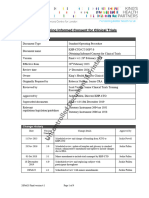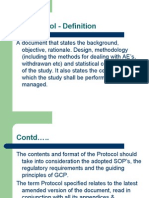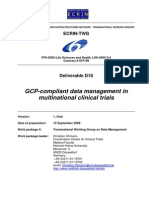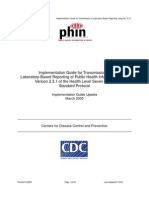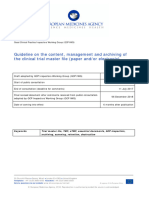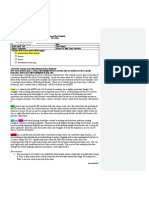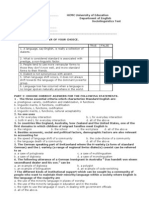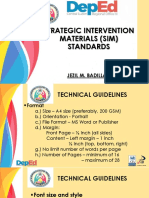The King's Health Partners Clinical Trials Office Case Record Form Design
The King's Health Partners Clinical Trials Office Case Record Form Design
Uploaded by
Rubén Fernández - SofpromedCopyright:
Available Formats
The King's Health Partners Clinical Trials Office Case Record Form Design
The King's Health Partners Clinical Trials Office Case Record Form Design
Uploaded by
Rubén Fernández - SofpromedOriginal Title
Copyright
Available Formats
Share this document
Did you find this document useful?
Is this content inappropriate?
Copyright:
Available Formats
The King's Health Partners Clinical Trials Office Case Record Form Design
The King's Health Partners Clinical Trials Office Case Record Form Design
Uploaded by
Rubén Fernández - SofpromedCopyright:
Available Formats
The King’s Health Partners Clinical Trials Office
Case Record Form Design
Policy Details
Document Type Standard Operating Procedure
KHP-CTO/CT/SOP8.0
Document name
Case Record Form Design
Version Final version 5.0 05/Feb/2021
Effective from 11th February 2021
Review date 5thth February 2024
Owner King’s Health Partners Clinical Trials Office
Originally Prepared by Helen Critchley, Senior Clinical Research Associate
Reviewed by Amy Holton, KHP-CTO Quality Manager
Approved by Jackie Pullen, Director, King’s Health Partners
Clinical Trials Office
Superseded documents Version 4.1 24/Oct/18
Relevant Statutory Instrument 2004 no 1031
regulations/legislation/guidelines
Statutory Instrument 2006 no 1928 (as amended from
time to time)
Change History
Date Version Change details Approved by
Number
28/Feb/2012 2.0 Administrative changes to formatting and Jackie Powell
change in the department name from
JCTO to KHP-CTO
14/Oct/2014 3.0 Administrative changes to formatting. Jackie Pullen
05/Feb/21 Final Version 5.0 Page 1 of 10
17/Jan/2018 4.0 Update to the glossary and minor Jackie Pullen
amendments ti the table in section 4.1
24/Oct/2018 4.1 Minor amendment to include trials Jackie Pullen
managed by KHP-CTO
05/Feb/2021 5.0 Clarifications to sections 2.0, 4,1, 4.2, Jackie Pullen
4.7 and 4.8. Addition of section 4.9 -
Archiving. Administrative changes to
formatting.
05/Feb/21 Final Version 5.0 Page 2 of 10
Table of Contents
1. 0 GLOSSARY .................................................................................... 4
2.0 BACKGROUND AND PURPOSE ................................................... 5
3.0 SCOPE ........................................................................................... 5
4.0 PROCEDURE ................................................................................. 6
4.1 General Forms ........................................................................................ ......6
4.2 General Principles ........................................................................................ 7
4.3 Format ........................................................................................................... 8
4.4 Layout ........................................................................................................... 8
4.5 Data Collection ............................................................................................. 8
4.6 Trial Specific CRF Completion Guidelines: ............................................... 9
4.7 CRF approval process: ................................................................................ 9
4.8 CRF amendment........................................................................................... 9
5.0 RELATED TEMPLATES............................................................... 10
5.1 CRF templates ............................................................................................ 10
5.2 CRF Approval Form ................................................................................... 10
6.0 RELATED DOCUMENTS ............................................................. 10
6.1 CRF Design and Approval Process Map .................................................. 10
6.2 CRF Design Manual ................................................................................... 10
6.3 Document Version Control Guidelines .................................................... 10
6.4 CRF Completion Guidelines ........................................................................... 10
7.0 APPROVAL and SIGNATURE ..................................................... 10
05/Feb/21 Final Version 5.0 Page 3 of 10
1. 0 GLOSSARY
Case Record Form (CRF) – “a printed, optical, or electronic document designed to record all
of the protocol required information to be reported to the sponsor on each trial subject”.
Chief Investigator (CI) - A Registered Physician, Dentist, Pharmacist or Registered Nurse
who has overall responsibility for the conduct of the study.
Clinical Research Associates (CRAs) – Members of the KHP-CTO Quality Team who
monitor trials to ensure GCP compliance
Clinical Trial - Any investigation in human participants, other than a non-interventional trial
intended to discover or verify the clinical, pharmacological or other pharmacodynamic effects
of one or more medicinal product or to identify any adverse reactions to one or more such
products and to study absorption, distribution metabolism and excretion in one of more such
products with the object of ascertaining the safety or efficacy of those products
Electronic Data Capture (EDC) - a computerised system designed for the collection of
clinical data in electronic format for in clinical trials.
Good Clinical Practice (GCP) – As defined in Statutory Instrument 2006/1928.
King’s Health Partners (KHP) – Kings Health Partners Academic Health Science Center is
a pioneering collaboration between one of the King’s College London (University) and three
of Londond’s most successful NHS Foundation Trusts - Guy’s & St Thomas’ NHS
Foundation Trust, King’s College Hospital NHS Foundation Trust and South London &
Maudsley NHS Foundation Trust
The King’s Health Partners Clinical Trials Office (KHP-CTO) Established in 2006 by
Kings College London, Guy’s & St Thomas’ NHS Foundation Trust and King’s College
Hospital NHS Foundation Trust to provide a streamlined approach for all aspects of trial
administration.
KHP-CTO Standard Operating Procedure (SOP) – "detailed, written instructions to achieve
uniformity of the performance of a specific function," SOPs are the base on which Quality
Systems and Processes are conducted and monitored against.
The Medicines & Healthcare products Regulatory Agency (MHRA) - UK Competent
Authority responsible for regulation of clinical trials.
The Regulations - Medicines for Human Use (Clinical Trial) Regulations 2004 transposed
the EU Clinical Trials Directive into UK legislation, as Statutory Instrument 2004 no 1031.
This became effective on the 1st May 2004. An amendment to implement Directive
2005/28/EC was made to the Regulations as Statutory Instrument 2006 no 1928 (as
amended from time to time).
Quality Policy - Policy signed by the Medical Directors’ of the Partner Organisations and the
Vice Principal of the Health Schools of King’s College London. The Quality Policy binds all
05/Feb/21 Final Version 5.0 Page 4 of 10
relevant clinical research activity conducted or managed by the Partner Organisations to the
Clinical Trial SOPs.
Remote Data Capture (RDC) - Remote data capture is the process of automatic collection
of data.
2.0 BACKGROUND AND PURPOSE
The purpose of this Standard Operating Procedure (SOP) is to describe the standard
procedures to be followed when designing and developing CRFs for use within a Clinical
Trial. The CRF is a data capturing tool used in all Clinical Trials to record eligibility of a
participant and to capture the required data as defined by the trial protocol for each individual
trial participant during the course of his/her participation in a trial. CRFs may be printed or
electronic documents. The type of CRF used for the trial will vary according to the
requirements of each individual study. The Chief Investigator and Quality Manager will
decide what CRF is most suitable for each trial however the principles outlined in this
document remain the same for both systems. The design of the CRF and its completion have
a direct impact on the quality of the Clinical Trial data. It is subject to quality assurance and
control during monitoring for GCP compliance on behalf of the Sponsor by the KHP-CTO (or
other organization from time to time), as well as during audits and inspections by the MHRA
and REC.
The CRF will be designed in an appropriate format in order to collect only trial data as set out
in the protocol for planned analyses. A well-designed CRF will ensure that no essential data
is missed and that data queries are kept to a minimum as well as aiding data management,
statistical analysis and reporting.
This SOP will ensure that CRF design enables trials sponsored or co-sponsored by the
Partner Organisations comply with the regulations encompassed in the UK and European
Law.
SI 2006/1928 Part 2 Conditions and Principles which apply to all Clinical Trials:
“9. All clinical information shall be recorded, handled and stored in such a way that it
can be accurately reported, interpreted and verified, while the confidentiality of
records of the trial subjects remains protected”
3.0 SCOPE
All Clinical Trials sponsored by one or more of King’s Health Partner Organisations, or
clinical trials where the sponsor responsibilities are managed by the KHP-CTO.. An
exception being when a Clinical Trial is co-sponsored with organisations other than the
Partner Organisations and the task of CRF design is delegated to the other organisation.
However, this SOP can be referred to if the other party does not have a CRF design SOP in
place.
05/Feb/21 Final Version 5.0 Page 5 of 10
When EDC or RDC is planned to be used for capturing Clinical Trial data, the principles
defined in this SOP are applicable.
4.0 PROCEDURE
CRF design is the responsibility of the CI or delegate, but should involve other members of
the team, including but not limited to: researchers, trial coordinators or managers, research
nurses, data managers and statisticians.The final CRF will be available before the first
patient is enrolled in to the Clinical Trial.
4.1 General Forms
The CRF will be designed to ensure that all data required by the protocol and statistical
analysis are captured in an appropriate format; only data defined in the protocol will be
entered into the CRF.
The following forms are normally found in a standard CRF (see related template for
examples in section 5.1). However, this list is not exhaustive – mandatory forms are
highlighted as bold. Depending on individual trial requirements additional forms may/will be
added:-
Case Record Form
Unambiguous participant identity code and visit dates
Baseline data including:
Confirmation of consent & Demographics
Medical History, and if applicable, prior treatment
Screening History of diagnosis studied (if applicable)
Physical Examination
Inclusion / Exclusion criteria review
Initial Primary and Secondary Endpoint Data (if applicable)
Participant Eligibility Review
Randomisation / Registration
Confirmation of randomisation (if applicable)
Administration of Trial Medication
Data during treatment period Safety and/or Efficacy Assessments
Participant Status
Primary and Secondary Endpoint Data
Adverse Events Adverse Events Log
Concomitant Medication Form Concomitant Medication data on protocol-defined period of
05/Feb/21 Final Version 5.0 Page 6 of 10
recording
Trial Completion Trial Completion form
Follow-up Concomitant Medications, if applicable
Unscheduled Form (if applicable) Data for visits that are not protocol scheduled visits
CRF Final page Principal Investigator sign off
4.2 General Principles
When designing a CRF, the following general principles will be considered:-
• Adopt a standardised format to achieve consistency in data recording.
• Ensure that the data to be captured is entered into the CRF in a logical order –
take in to account, for example, the order of trial procedures during a trial visit,
order of entry in medical notes and laboratory reports.
• Collect raw data to minimise unnecessary calculations and conversions.
• Structure the layout in an organised manner to minimise transcription error where
data will be transcribed from source documents to CRF.
• A Comments Form can be included in the CRF where comments can be
recorded centrally. However free-text entry cannot be analysed and hence
should be kept to the minimum
• Separate the CRF into sections by visit to ease organisation, and include a
checklist at the front of each section as reminder of assessments required per
visit.
• Provide a CRF trial schedule, to indicate which CRF pages are applicable to
particular visits.
• Use questions, prompts and provide instructions, which must be clear and
concise and must not contradict other CRF pages or the protocol.
• Ensure that copyright permissions are obtained for the replication of any licensed
measures (i.e. questionnaires), where applicable
05/Feb/21 Final Version 5.0 Page 7 of 10
4.3 Format
The CRF will:-
• Be clearly version controlled; by version number and date (see section 6 of the
Document Version Control Guidelines).
• Be page numbered in sequential order. In cases where multiple page insertions
are required, eg, Adverse Event Form and Concomitant Medication Form, the
use of sub-numbering may be appropriate. (The following numbering pattern can
be followed: the initial page as XXX.0, the suffix will increase sequentially with
each inserted page as XXX.1, XXX.2, XXX.3).
• Be in chronological order, clearly identifying the visit or data collection point, as
defined in the protocol.
• Have sufficient information in the header, to identify EVERY CRF page - for
example, trial name, protocol number, patient trial number and initials. Hospital
numbers are not acceptable as patient identifiers.
• Have an appropriate number of boxes for the digits required, for example, date,
laboratory results, and vital signs readings.
• Have pre-printed decimal points where applicable.
• Specify units if appropriate, ensuring units are the same as that in the protocol
and source documents.
• Have a designated area for sign-off at eligibility review and at the end of the CRF
by the investigator.
4.4 Layout
The layout of the CRF will:
• Be consistent throughout the entire CRF including alignment, page margins,
spacing and fonts.
• Have sufficient space in the page margin to accommodate hole punching/binding.
• Have text aligned with associating boxes where applicable.
• Not be overly cramped.
4.5 Data Collection
By specifying a required format for data entry, the responses received will be supplied in a
uniform manner.
• Data collected as “free text” should be limited as far as possible, as this
complicates data analysis, wherever possible use boxes to ensure consistency.
i) |_|_|-|_|_|_|-|_|_|_|_|
ii) Date:________________
DD - MMM - YYYY
05/Feb/21 Final Version 5.0 Page 8 of 10
• Listing definitive options with checkboxes will demand defined responses to
minimise ambiguity.
e.g.
Has the patient had any Adverse Events? No Yes
• Using a combination of definitive options, and option to enter “other” or “specify”
will allow for the collection of additional information if applicable.
e.g.
Origin: White / Caucasian
Black or African
Oriental
Other, specify: _______________________
• When assessing subjective variables e.g. pain, only use validated instruments.
4.6 Trial Specific CRF Completion Guidelines:
Trial specific CRF completion guidelines may be generated if required and can be a useful
training tool for accurate data entry and CRF completion.
4.7 CRF approval process:
CRF design is a multidisciplinary process, involving collaboration with the research team, the
trial statistician, data management (if applicable) and KHP-CTO CRA. An independent
review will ensure quality control is maintained (e.g. by Statistician, trial CRA)Documented
approval of the CRF by the Chief Investigator is mandatory (see section 5 for CRF approval
form template) and evidence of review must be retained in the Trial Master File. The CRF
should be finalised prior to the first patient being enrolled into the trial.
4.8 CRF amendment
Amendments to the CRF may be required from time to time due to, for example, a change of
trial design or a change in data requirements as specified in an amendment to the protocol
and /or statistical analysis plan. Amendments to the CRF should be made during the
amendment approval process, the current version of the CRF should be consistent with the
current version of the protocol. All CRF amendments will be tracked by the version number
and date and approval documented in the Trial Master File. Where paper CRFs are being
used updated versions should be provided to all sites and filed in the ISF. Superseded
05/Feb/21 Final Version 5.0 Page 9 of 10
versions should be marked as such and retained in the TMF/ISF. eCRFs should be updated
and finalised before the amendment is implemented.
4.9 Archiving
CRFs shall be archived according to the requirements outlined in the Sponsor’s protocol.
5.0 RELATED TEMPLATES
5.1 CRF templates
5.2 CRF Approval Form
6.0 RELATED DOCUMENTS
6.1 CRF Design and Approval Process Map
6.2 CRF Design Manual
6.3 Document Version Control Guidelines
6.4 CRF Completion Guidelines
6.5 Data Management Plan Template
7.0 APPROVAL and SIGNATURE
11 February 2021
_________________________________ _________________
Jackie Pullen Date
Director
King’s Health Partners Clinical Trials Office
05/Feb/21 Final Version 5.0 Page 10 of 10
You might also like
- Sample Management in Clinical TrialsDocument8 pagesSample Management in Clinical TrialstheanhdbtNo ratings yet
- 7.0 Obtaining Informed Consent v4.1Document9 pages7.0 Obtaining Informed Consent v4.1Ennda Riiska SembiringNo ratings yet
- BT-11-202 eTMF Maintenance Plan - Version1.0 - 05apr2021 - Final - Fully - SignedDocument20 pagesBT-11-202 eTMF Maintenance Plan - Version1.0 - 05apr2021 - Final - Fully - SignedAdnan MuharemagicNo ratings yet
- 1 1 Production Review and Approval of Jcto SopsDocument6 pages1 1 Production Review and Approval of Jcto SopsSreeraj Guruvayoor SNo ratings yet
- Standard Operating Procedure SOP 305 Creating and Maintaining A Trial Master FileDocument9 pagesStandard Operating Procedure SOP 305 Creating and Maintaining A Trial Master Filemo2bioNo ratings yet
- Standard Operating Procedure PathologySampling v4.1Document15 pagesStandard Operating Procedure PathologySampling v4.1Davindu AnushkaNo ratings yet
- Electronic SLP-FDADocument8 pagesElectronic SLP-FDAlisschavezNo ratings yet
- Lab Manual & Quality PoliciesDocument48 pagesLab Manual & Quality PoliciesSadia Sharmin Nilima100% (2)
- FDA指南-矫形硬性透气隐形眼镜上市前提交指南Document72 pagesFDA指南-矫形硬性透气隐形眼镜上市前提交指南chevonneNo ratings yet
- A Guideline For Manufacturers of InsulatDocument23 pagesA Guideline For Manufacturers of InsulatwaqargilllNo ratings yet
- VMP NihDocument163 pagesVMP Nihjpmaurya77No ratings yet
- Safer Technologies Program GuidanceDocument23 pagesSafer Technologies Program Guidanceasma.shaikhNo ratings yet
- Guidance For Industry: Computerized Systems Used in Clinical InvestigationsDocument13 pagesGuidance For Industry: Computerized Systems Used in Clinical Investigationsx7w34TNo ratings yet
- Protocol Regen 006 20mar24 SignedDocument111 pagesProtocol Regen 006 20mar24 SignedMaximiliano CarmonaNo ratings yet
- The Special 510 (K) ProgramDocument36 pagesThe Special 510 (K) Programnahrat3637No ratings yet
- E2C Addendum To ICH E2C Clinical Safety Data Management Periodic Safety Update Reports For Marketed DrugsDocument12 pagesE2C Addendum To ICH E2C Clinical Safety Data Management Periodic Safety Update Reports For Marketed Drugs涂皇堯No ratings yet
- QE5 Biotecnologicos FdaDocument17 pagesQE5 Biotecnologicos FdaAntonio SanchezNo ratings yet
- A ProtocolDocument14 pagesA ProtocolSanjeev KuridiNo ratings yet
- HL7 AmbulatoryCareLabResultSpecification-R1 v2.5.1Document261 pagesHL7 AmbulatoryCareLabResultSpecification-R1 v2.5.1Tom NagelsNo ratings yet
- ECRIN Report D10 Vers1 Final 150908Document49 pagesECRIN Report D10 Vers1 Final 150908rr48843No ratings yet
- SADCAS TR 08 - Proficiency Testing and Other Comparison Programmes Requirements For Testing and Medical Labs (Issue 4)Document7 pagesSADCAS TR 08 - Proficiency Testing and Other Comparison Programmes Requirements For Testing and Medical Labs (Issue 4)Kialanda Fidel LuvumbuNo ratings yet
- Audit Manual Clinical TrialDocument22 pagesAudit Manual Clinical TrialnikjadhavNo ratings yet
- SOP - 01 - Preparation - of - SOPsPreparation, Review and Approval of Standard Operating Procedures For ResearchDocument20 pagesSOP - 01 - Preparation - of - SOPsPreparation, Review and Approval of Standard Operating Procedures For Researchramkarn7989No ratings yet
- PQS/E003: A Guideline For Manufacturers of Vaccine Refrigerators, Vaccine Freezers and Water-Pack FreezersDocument22 pagesPQS/E003: A Guideline For Manufacturers of Vaccine Refrigerators, Vaccine Freezers and Water-Pack FreezersBerna SaefullahNo ratings yet
- Q6B Specifications Test Procedures and Acceptance Criteria For Biotechnological Biological ProductsDocument24 pagesQ6B Specifications Test Procedures and Acceptance Criteria For Biotechnological Biological ProductsKenechukwu IgweNo ratings yet
- Standard Operating Procedure For Archiving Essential Documentation Relating To Clinical Trials of Investigational Medicinal Products (Ctimps)Document8 pagesStandard Operating Procedure For Archiving Essential Documentation Relating To Clinical Trials of Investigational Medicinal Products (Ctimps)Emeka NkwochaNo ratings yet
- 18 - FFTF - Appendix 3 Draft PIDDocument13 pages18 - FFTF - Appendix 3 Draft PIDSandersNo ratings yet
- Eda Guideline (Validation Protocol)Document79 pagesEda Guideline (Validation Protocol)mohamedzahafa2No ratings yet
- Ucm 081293Document15 pagesUcm 081293muzammil21_adNo ratings yet
- MaPP CMC QBB November 2014 PDFDocument12 pagesMaPP CMC QBB November 2014 PDFP S R PrasadNo ratings yet
- Ucci T Document FrameworkDocument12 pagesUcci T Document FrameworkMagneto Eric Apollyon ThornNo ratings yet
- Ctis Training Programme1Document10 pagesCtis Training Programme1chris2272No ratings yet
- Sop Title: Assessing Protocol Feasibility: Sop No: Effective DateDocument7 pagesSop Title: Assessing Protocol Feasibility: Sop No: Effective Datetiara rengganis100% (1)
- Uclh Sop 8 Essential Documents and Investigator Site File v3 02.09.2019 CleanDocument8 pagesUclh Sop 8 Essential Documents and Investigator Site File v3 02.09.2019 Cleannijam.ueNo ratings yet
- Quality Assurance Policy and Procedures: Publications and Information ProductsDocument30 pagesQuality Assurance Policy and Procedures: Publications and Information ProductsMary Hope A. LimaNo ratings yet
- EU CER WhitepaperDocument5 pagesEU CER Whitepaperibrahim kademogluNo ratings yet
- Q4B Annex 5 - R1 - Step 4 PDFDocument6 pagesQ4B Annex 5 - R1 - Step 4 PDFalexpharmNo ratings yet
- Core Lab All Com 10-24-22Document52 pagesCore Lab All Com 10-24-22Sarah Carlisle100% (1)
- Title: Guideline For Registration of Allopathic/medicinal Products (Common Technical Document) - Quality PartDocument124 pagesTitle: Guideline For Registration of Allopathic/medicinal Products (Common Technical Document) - Quality Partomorfaruk108No ratings yet
- PHIN Laboratory Result ELR v231Document86 pagesPHIN Laboratory Result ELR v231anujaks_rlbNo ratings yet
- Who PQS E001 Guide1.3Document23 pagesWho PQS E001 Guide1.3QFCarlosCQNo ratings yet
- Menstrual Tampons and Pads Information For Premarket Notification Submissions (510 (K) S) Guidance For Industry and FDA Staff PDFDocument19 pagesMenstrual Tampons and Pads Information For Premarket Notification Submissions (510 (K) S) Guidance For Industry and FDA Staff PDFHimanshu PanchalNo ratings yet
- Known Quality Protocols Guidance PDFDocument114 pagesKnown Quality Protocols Guidance PDFSeleneArthurNo ratings yet
- Lab Manual Quality PolicyDocument44 pagesLab Manual Quality Policydeepak_023No ratings yet
- Clinical Trials Information System - Sponsor HandbookDocument37 pagesClinical Trials Information System - Sponsor HandbookarvanitisdimitrisNo ratings yet
- The Drug Manufacturers Guide To Site Master Files ExecSeriesDocument65 pagesThe Drug Manufacturers Guide To Site Master Files ExecSeriesasit_m100% (1)
- 019 - Proficiency Testing in Transfusion ServicesDocument5 pages019 - Proficiency Testing in Transfusion ServicesFathima SiyadNo ratings yet
- TMF GuidanceDocument17 pagesTMF Guidancemajerova.sarkaNo ratings yet
- Ilac G18 04 2010 PDFDocument11 pagesIlac G18 04 2010 PDFSutarwanto Siswo MulyonoNo ratings yet
- Safer Surgery UHL PolicyDocument27 pagesSafer Surgery UHL PolicyAsmaa Awad AtiyaNo ratings yet
- WHO - PQS - Standard Operating Procedures PDFDocument208 pagesWHO - PQS - Standard Operating Procedures PDFLenin Fernandez ArellanoNo ratings yet
- Clinical Pharmacology and Therapeutics Curriculum 2010.pdf 32486220.pdf 43283103 PDFDocument83 pagesClinical Pharmacology and Therapeutics Curriculum 2010.pdf 32486220.pdf 43283103 PDFMohamed KhattabNo ratings yet
- Guidelines On Conducting Clinical Research in Hospital Kuala LumpurDocument40 pagesGuidelines On Conducting Clinical Research in Hospital Kuala Lumpurnafsiyah xyzNo ratings yet
- Sample Test PlanDocument18 pagesSample Test Planhungnvhe176800No ratings yet
- Sop To Achieve GCP Clinical ResearchDocument195 pagesSop To Achieve GCP Clinical Researchشادي الاخرس100% (1)
- GenericGuideline PDS CTD-FormatDocument12 pagesGenericGuideline PDS CTD-FormatEIRINI STAMOPOULOUNo ratings yet
- Portal PidDocument34 pagesPortal Pidsenjatatradisional324No ratings yet
- Standards Document 24A Version 5Document110 pagesStandards Document 24A Version 5Amgad Kamel MarzoukNo ratings yet
- Guidelines for Implementing Process Safety ManagementFrom EverandGuidelines for Implementing Process Safety ManagementNo ratings yet
- Teaching Internship HandbookDocument42 pagesTeaching Internship HandbookSusan TorregozaNo ratings yet
- Jolibee: Areas Need To Be InspectedDocument3 pagesJolibee: Areas Need To Be InspectedSasha AbejeroNo ratings yet
- Ism Lesson PlanDocument6 pagesIsm Lesson Planapi-505224160No ratings yet
- Business PlanDocument7 pagesBusiness Planapi-404348823No ratings yet
- 2014-Furrer Skinner PitzerDocument24 pages2014-Furrer Skinner PitzerAnis TajuldinNo ratings yet
- Importance of InstructionalDocument4 pagesImportance of InstructionalNasbulNo ratings yet
- Social Responsblty OutputDocument23 pagesSocial Responsblty Outputjanine mujeNo ratings yet
- State of Nebraska: Funeral Directing and EmbalmingDocument7 pagesState of Nebraska: Funeral Directing and EmbalmingMatthew B. MaupinNo ratings yet
- Useful Phrases For Proficiency EssaysDocument3 pagesUseful Phrases For Proficiency EssaysAna ĐurovićNo ratings yet
- National Exam June 2008 SciencesDocument3 pagesNational Exam June 2008 SciencesOmar BelazriNo ratings yet
- Yash Mehrotra (Luckhnow, India)Document2 pagesYash Mehrotra (Luckhnow, India)Yash MehrotraNo ratings yet
- Sociolinguistics TestDocument2 pagesSociolinguistics Testruoimama84% (19)
- Portfolio Reduced SizeDocument52 pagesPortfolio Reduced SizeJohn QuigleyNo ratings yet
- PYP Exhibition - Letter To MentorsDocument1 pagePYP Exhibition - Letter To MentorsCristina100% (1)
- Dea Special AgentDocument4 pagesDea Special Agentapi-509996268No ratings yet
- Supervisory Development ProgramDocument2 pagesSupervisory Development ProgramtetrahedronNo ratings yet
- Mis Role in Production 12Document18 pagesMis Role in Production 12pugs_rockon100% (10)
- SLM2 - ENTREP - M2W4 - The Product Development - GCRDocument20 pagesSLM2 - ENTREP - M2W4 - The Product Development - GCRJumanjiNo ratings yet
- Human Resource Development in Small Island Setting: The Case of The Maldivian Tourism and Hospitality IndustryDocument17 pagesHuman Resource Development in Small Island Setting: The Case of The Maldivian Tourism and Hospitality IndustryRufus LintonNo ratings yet
- Priciples of Marketing by Philip Kotler and Gary ArmstrongDocument45 pagesPriciples of Marketing by Philip Kotler and Gary ArmstrongnipscNo ratings yet
- Article1379501068 Smihula PDFDocument11 pagesArticle1379501068 Smihula PDFRio AwitinNo ratings yet
- Philippine Popular Culture Finals Quiz 1 Finals Exam 2Document21 pagesPhilippine Popular Culture Finals Quiz 1 Finals Exam 2Alyssa marie67% (3)
- Penpal Project 2021 in Conjunction of Highly Immersive Programme SK Penghulu Ahmad, Ayer Hangat, 07000 Langkawi, KedahDocument3 pagesPenpal Project 2021 in Conjunction of Highly Immersive Programme SK Penghulu Ahmad, Ayer Hangat, 07000 Langkawi, KedahMissxNisyaNo ratings yet
- Strategic Intervention Materials (Sim) Standards: Jezil M. BadillaDocument19 pagesStrategic Intervention Materials (Sim) Standards: Jezil M. BadillaZudotaNo ratings yet
- Relationship Between Motivation and PerformanceDocument24 pagesRelationship Between Motivation and PerformancekierselennNo ratings yet
- TOYOTA MOTOR PHILS vs. NLRCDocument2 pagesTOYOTA MOTOR PHILS vs. NLRCAreeNo ratings yet
- Hera Build OrdersDocument15 pagesHera Build Orderszuku75% (4)
- WBCS AgricultureDocument2 pagesWBCS AgricultureAgradeep ChandaNo ratings yet
- Thrive PDFDocument14 pagesThrive PDFShehzadi Mahum (F-Name :Sohail Ahmed)No ratings yet
- MHR 300 Live - Course Syllabus Fall 2010 - FINAL5-XDocument24 pagesMHR 300 Live - Course Syllabus Fall 2010 - FINAL5-XBen WilliamsNo ratings yet

